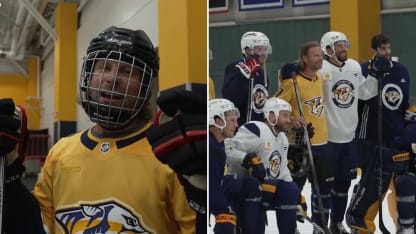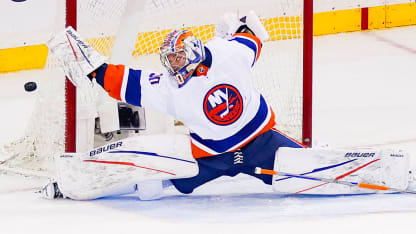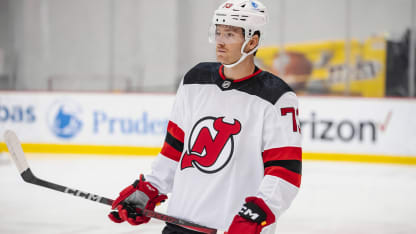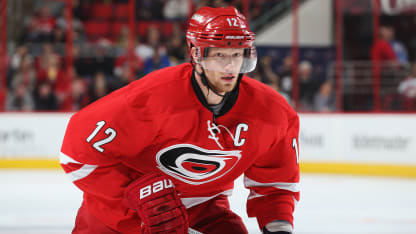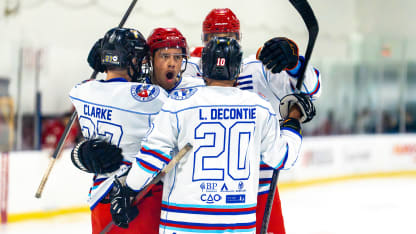TALKING POINTS: Bowman discusses Holloway & Broberg offer sheets
TALKING POINTS: Bowman discusses Holloway & Broberg offer sheets
Read the complete transcript where Edmonton’s General Manager and Executive Vice President of Hockey Operations spoke to the media on Tuesday about the team’s choice to not match the offer that the St. Louis Blues made to the forward and defenceman.
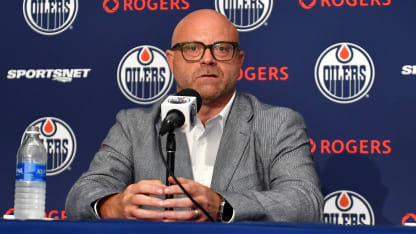
EDMONTON, AB – Oilers General Manager & Executive Vice President of Hockey Operations Stan Bowman held a virtual media availability on Tuesday to discuss the team’s decision to not match the offer sheets presented by the St. Louis Blues to restricted free agent forward Dylan Holloway and defenceman Philip Broberg.
Bowman’s opening comments:
Greetings to all. I am grateful for your time and acknowledge the numerous questions that you have. I am ready and eager to provide answers. I believe it would be beneficial to begin with an overview of what we have been doing since we received the offer sheets last week. I would like to share our thought process behind the decision we made and then I’ll be glad to entertain your questions. So, the moment the offer sheets arrived last week, we, as a team, sprung into action. Our goal was to assess our situation at that point and explore all possible options. We didn’t dismiss any possibility immediately. Our approach was methodical, and as we saw it, we had essentially four options to consider.
We considered four different strategies. The first one involved matching both offer sheets, the second one was to match Broberg but not Holloway, and the third one was the opposite – matching Holloway but not Broberg. The fourth strategy was to not match either of them. We dedicated several days to explore each of these scenarios in terms of their impact on our team in the immediate, shorter, and longer term. We attempted to visualize how our team would evolve under each scenario. Finally, we made a decision based on what seemed most beneficial for our current situation.
The staff performed exceptionally well in meticulously analyzing and evaluating various options. Whenever we identified potential leads for further investigation, I engaged in numerous phone calls with nearly every team in the league. These conversations primarily aimed to understand their roster intentions, whether they planned to offload or acquire any players. We left no stone unturned in our efforts. Despite this, we concluded today without matching any offer sheets.
To put it plainly, our decision was not a reflection on the players, nor did we have any concerns about them. It was a business decision considering our immediate and future financial standing with the salary cap. Consequently, we were able to conduct other transactions. Once we decided not to match the offer sheets, we knew we would acquire some assets, leading to further discussions. By managing this situation, we believe we’ve achieved a few things which provide us with substantial flexibility and options in the future, which was crucial for us.
We didn’t limit ourselves to a single direction for this season, hence our subsequent moves to recruit young players and additional draft picks and prospects. Looking at the situation as a whole, it was indeed challenging but I believe we made the best series of transactions that have put us in a favorable position as we head into training camp.
Stan addresses the media about the offer sheets from Holloway and Broberg.
On having an older team with some veteran free agent additions:
There are several perspectives to consider here. Undeniably, the Oilers’ recent trajectory highlights their attractiveness to players seeking a championship more than individual glory. Each player’s decision is unique and influenced by their career stage. It’s clear that players opting for Edmonton, potentially forgoing higher salaries, are drawn to something special in our team. We hope this trend continues as it aligns with our team goals. To ensure this in the future, we aim to maintain a competitive team that attracts players who prioritize victory and see Edmonton as their desired destination.
I wouldn’t claim that we’re exclusively focused on older players. Indeed, there are advantages to having older players, given their extensive experience and exposure to diverse situations, which is valuable. However, we’ve also incorporated a few young players with NHL experience into our organization. These players, including Podkolzin and Ty Emberson, are striving to become regular NHLers.
This isn’t a black-and-white issue. There are certainly advantages to including young players in your roster, as they can bring a fresh perspective and typically more energy and enthusiasm. They may not have been in the NHL for long, or even at all, which can add another layer of excitement. We’re definitely open to having younger players on the team. However, it will likely be a blend of both young and experienced players. The crucial common factor for players like Podkolzkin and Emberson is that their salary cap hits are manageable. Given the current and future state of our team, maintaining salary cap space and flexibility is essential. Younger and older players usually have lower cap hits, while those in the middle of their careers often have higher contracts.
On the possibility of two younger players dictating the team’s salary cap position:
Returning to my initial remarks, we were assessing our situation when we received those offer sheets. Considering this and other constraints, we felt it was not the correct decision to effectively limit our options, not just for this year, but also for the future. It’s not about the players’ skills or talents, but about positioning ourselves optimally for future opportunities. We’re now in August, and every team faces highs and lows each season. It’s unpredictable which players will excel or underperform, so adaptability is key. The other scenarios, either matching both or one of the offers, would have significantly impacted our salary cap for the current season, and potentially future ones. Therefore, we chose the path we did.
On losing two defencemen from last season in Broberg and Cody Ceci:
Indeed, we do have it. It’s crucial for us to establish a robust defensive strategy before we hit the home stretch. I believe we are currently blessed with numerous alternatives, and we have players who we are hopeful can step up and play a significant role for us. It’s true that our mix isn’t the same as it was in Game 7 a few months ago. Therefore, one of our priorities is to give them an opportunity to prove their worth, as we have some new defenders on board.
Stecher may not be a new face, but he didn’t get much playtime towards the end of last season. Along with him, we have Brown and Emberson as well. These three players represent new opportunities for us, and we need to give them the chance to prove their worth. We’re optimistic that they can step up and fill bigger roles. Our team composition has changed, and we’re hopeful that these players can step up. On another note, I’ve mentioned previously that this situation provides us with a chance to save some cap space. If the need arises, we could potentially add another player to our squad. This opportunity is plausible in our current scenario.
On the start of contract extension negotiations with Leon Draisaitl:
I anticipated that question, which is quite understandable given the high level of interest in Leon. I can confirm that we have initiated discussions with Leon and his representative. However, I prefer not to comment further. Based on my past experiences, I’ve found that it’s best to maintain privacy with regard to these conversations. This is not a reflection on the nature of the discussions and should not be interpreted negatively. I simply don’t wish to impose any timelines. We’ve started the process and we will certainly provide updates as and when they occur.
On the injury status of Evander Kane heading into the season:
Let me clarify a few points as there seems to be some confusion regarding the handling of injured players, long-term injuries, and how their cap hit is replaced, etc. I’ll provide a brief overview here. When a player such as Evander is injured, his recovery plan will be decided between himself and the medical team. I don’t have any input in this matter, and neither should I. My primary responsibility is to support Evander and ensure his health recovery.
In the event of an injury, several options are available. You can receive treatment, undergo rehab, and eventually, the injury heals, enabling the player to return to the game. In some instances, surgery is the immediate and obvious solution. However, some injuries aren’t as straightforward, and the player has several options on how to proceed, which is their decision. We are standing by Evander in this. So, the current situation aligns with this third scenario. As such, we are unsure whether he will be absent for a short or long period of the season, should surgery be necessary. I am not involved in this decision; it is something he will figure out with his doctors.
I believe the relevance to this discussion lies in the misconception that an injured player, placed on long-term injury, doesn’t affect trades or present any issues. This isn’t entirely accurate, as such a player still needs to be accounted for within your salary cap. He can either be off long-term injury and included in your regular team cap, or if his injury extends beyond 24 days and 10 games, he can be listed as a long-term injury. However, you must have a plan to reactivate him when he recovers. During our discussions, it became clear that while a player might start the season on long-term injury, if he is going to be sidelined for at least a month, we need a strategy for his return. This proved to be a significant challenge.
One point worth noting is that no cap space is accumulated during a long-term injury. Hence, if a player is on long-term injury for a few months and then activated, you start from zero cap space and attempt to build it. Therefore, it’s challenging to amass a significant amount in just a month or so. These considerations factored into our decision-making process. Given our current situation, we anticipate starting the season with Evander Kane free from any injury, just like the rest of the team. If he can play immediately, that’s excellent. If not, we’ll have no issue making room for him once he’s fit.
On the additions of Vasily Podkolzin, Ty Emberson and Paul Fischer:
I can provide some background information on all three mentioned players. During situations like this past week, our protocol involves reaching out to our staff and exploring any connections they might have had with the players under discussion for potential transfer. Specifically concerning Emberson, I had a conversation with Kris (Knoblauch), who has first-hand experience coaching Ty. Kris spoke highly of Ty’s performance and enjoyed having him on his Hartford team. This comfort level between a coach and a player is vital, though not always present, especially if they’ve worked together before. This familiarity was helpful in this case.
Podkolzin was a high pick, coming in at 10th overall, which speaks to his talent and pedigree. He had a commendable rookie year in the NHL, but he hasn’t been able to maintain that level of performance. He spent most of his time in the American League since then, especially after a change in management. It’s not uncommon for players to struggle when things change, but it’s not necessarily anyone’s fault. I admire Podkolzin and his skills; he’s capable of scoring and is a powerful, strong player. He plays a direct, physical game, which is something I find impressive. His strength allows him to dominate in possession games in the offensive zone and he’s not afraid to take on opponents physically. I believe his combination of skills is impressive and I’m optimistic we can help him regain his earlier form, not only from his draft year but also his first professional year. This is now a task for our coaches and team to bring out the best in him. A fresh start can often be beneficial for players like Podkolzin.
I’ve known Paul Fischer for a long time. He was raised in Chicago and I’ve watched him grow from a young boy playing countless games to joining the U.S. national team. His trajectory was promising, but an injury during his draft year likely impacted his draft position. I also observed his performance last year at Notre Dame, where he established himself as a notable freshman defenseman, playing a significant role for the team. He’s also a potential candidate for the U.S. World Junior team. He’s a skilled and likeable player with a good physique, and though he’s young and has areas to improve, he has a great character and is dedicated to betterment. I know him personally and am confident in his commitment to improvement. It’s encouraging as we strive to strengthen our group here, investing time and effort in player development to not only find young prospects, but also aid in their rapid progression and development, hastening their journey to the NHL.
On Bowman’s initial reaction to receiving two offer sheets from the same team:
Undeniably, it was a difficult task. It’s rare to come across offer sheets and even more unusual to have two simultaneously. In response, I simply rolled up my sleeves and got down to business. I understand that from the perspective of fans or media, there may be a focus on other aspects, but I wasn’t preoccupied with that. My focus was on the future. We are now faced with a decision. We have a complex situation to resolve. It was certainly demanding to identify the best course of action. However, upon reviewing the entire scenario, I feel confident about managing it optimally and providing us with some future options.
On whether he harbours any negativity towards the Blues after the offer sheets:
I believe it’s crucial to distinguish between business and personal matters. I’ve known Doug Armstrong for quite some time. We’ve experienced many conflicts throughout the years, during my time in Chicago while he was still in St. Louis. However, I don’t view it from that perspective. I comprehend that every manager might potentially exploit this, and now it’s our responsibility to respond and act in our best interest. Personal emotions shouldn’t obstruct anything of this sort. We need to maintain a professional relationship with all league managers, which I plan to continue doing.
On the possibility of targeting any more players between now and the start of the season:
To rephrase, at this juncture, all options are on the table. I believe it’s detrimental to shut any doors at this moment. To clarify a prior point, we have several new team members that we must provide with a chance to prove themselves. They joined our team for a reason, and in the case of Emberson, we just traded for him. We aim to give them the opportunity to demonstrate their potential value to us. However, it is also my responsibility to explore all possibilities, be it through further trades or free agents currently available. I plan to pursue this, although I’m not certain if it will result in anything. We are still bound by the same constraints, and our salary cap remains unchanged. Therefore, we have been prudent in ensuring we retain some flexibility for the future. But in short, yes, we do have the ability to engage with players and assess if there’s anyone suitable to bring onboard.

